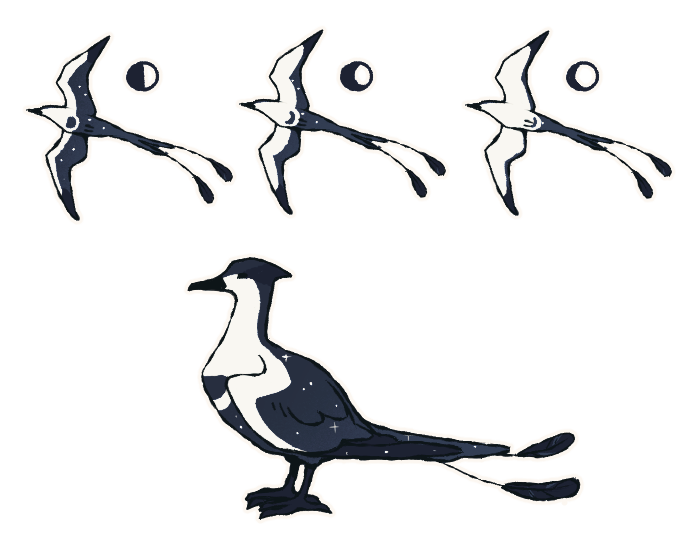 Waning Tide-Tern
Waning Tide-Tern
Wild

i. DESCRIPTION
Waning tide-terns are medium to large-sized seabirds that predominantly live among cloud tops. Due to the residual properties of Luminites, their physiology has been altered, allowing them to nest in clouds.
Adult waning tide terns have a flat head, long necks, and stout bodies. Their wings are long and angular, making them adapted to extended periods of hovering and controlled flight. The beak on a waning tide-tern is long and thin with a hook at the end, making them adapted to aerial fishing and tearing apart prey.
Juvenile waning tide-terns are all entirely white, except for a black crown and nape. Their beaks are a dusty gray color.
MOON CYCLE EFFECTS
Strangely, the appearance of waning tide-terns is directly impacted by the moon cycle. As pictured above, the pattern on their feathers changes in tandem with the moon's cycle.
ii. HABITAT
Most waning tide-terns are migratory birds, wintering in the southern regions of Anstar along coastal regions. Waning tide-terns often seen along the Sozyrian peninsula and the Vaseira-Sozyria inlet.
In warmer months, waning tide-terns are spotted as far north as Potae. They rarely venture into the peninsula, however, as the climate is too cold to have a reliable source of prey.
Waning tide-terns nest within clouds located above large bodies of water and land (e.g., lakes, inlets).
III. ECOLOGY AND BEHAVIOR
Waning tide-terns are social birds who travel in flocks. It's common to find a committee of waning tide-terns nesting together in pairs on the same cloud. They have even been observed sharing resources, such as fish and other prey.
Waning tide-terns are monogamous, establishing their pairs through aerial courtship displays. These displays have often been a spectacle of observing Luminites.
DIET
Waning tide-terns feed through plunge-diving into the ocean in search of fish. They will then return to their nest to share their prey with their partner and chicks.
IIII. CULTURAL DEPICTIONS and impact
Waning tide-terns have been a crucial part of Pleiades ecological history and play an important role as a cultural figurehead. They are the representative colony bird of Myrinth, where they are protected from hunting due to their rarity and importance.
Ever since Luminites settled within Pleiades, waning tide-terns have been used as a guide for keeping track of the cycles of Pleiades' two moons, allowing for ease of documentation with the changing seasons and tides.
It is said that putting the feather of a waning tide-tern in your bedroom at the beginning of a new moon will bring luck and peace.